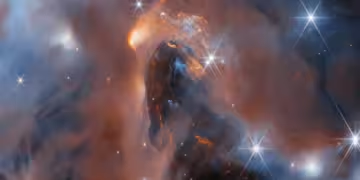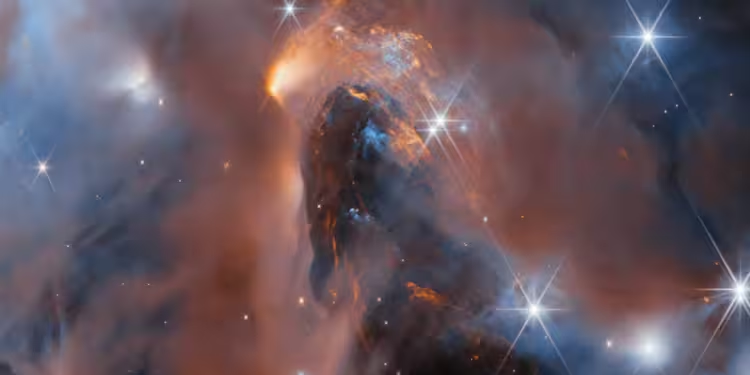The James Webb Space Telescope (JWST) has once again amazed astronomers with a discovery that challenges our understanding of how planets form. Peering into the nearby star cluster NGC 1333, JWST identified six rogue gas giants—planets that roam the cosmos alone, untethered to any star. Among these lonely worlds, one was found with a disk of dust swirling around it, raising new questions about the nature of rogue planets and their origins. Could these free-floating worlds form the same way as stars, rather than being kicked out of their star systems? Let’s dive into what makes this discovery so significant and what it tells us about the universe.
What Are Rogue Planets?
Rogue planets are celestial bodies that drift through space without a parent star. Unlike typical planets that orbit stars like our Sun, these gas giants wander the galaxy on their own. JWST’s recent findings in NGC 1333, a star-forming region about 1,000 light-years away in the constellation Perseus, unveiled six of these planetary nomads. Each of these planets is between five and ten times the mass of Jupiter, making them some of the lowest-mass objects known to form in a way similar to stars. These gas giants exist on the boundary between planets and brown dwarfs—objects too large to be considered planets but too small to ignite nuclear fusion and become stars.
The discovery of these rogue planets is reshaping how astronomers think about celestial formation. Previously, rogue planets were thought to be rare flukes, often explained as planets that formed around stars and were later ejected due to gravitational interactions with other planets or passing stars. However, JWST’s observations suggest a different story: some of these planets may have formed directly from collapsing clouds of gas and dust, much like stars do, but on a smaller scale. This insight blurs the line between star and planet formation and highlights the incredible diversity of celestial bodies in our galaxy.
Formation Theories – More Than Just Ejections
Traditionally, rogue planets were thought to originate from star systems, only to be ejected after a cosmic scuffle with a sibling planet or a close encounter with another star. This conventional view positioned rogue planets as unlucky exiles, booted from their home systems and doomed to wander the galaxy in solitude. But the JWST’s latest discovery challenges this narrative by showing that some rogue planets might not have been ejected at all; instead, they could have formed in isolation.
According to the research led by Johns Hopkins University astrophysicist Adam Langeveld, JWST’s observations revealed that these rogue planets have masses overlapping with giant exoplanets that orbit stars. One particularly intriguing rogue planet, about five times the mass of Jupiter, was found surrounded by a disk of dust—similar to the protoplanetary disks that form around young stars. This suggests that the planet likely formed directly from a smaller cloud of gas, just like a star, rather than being thrown out of a stellar system.
The presence of a dusty disk around a rogue planet is a game-changer. Disks are crucial for planet formation; they are the nurseries where moons, rings, and even smaller planets can form. The discovery of a rogue planet with its own disk implies that such planets could potentially host their own miniature systems, akin to Jupiter and Saturn with their extensive families of moons. This challenges our understanding of planetary dynamics and suggests that rogue planets could be more complex than previously thought.
Implications for Star and Planet Formation
The findings from JWST have significant implications for our models of star and planet formation. Traditionally, stars form when dense clumps of gas and dust in a nebula collapse under their own gravity, eventually igniting nuclear fusion at their cores. The discovery that rogue planets can form in similar ways suggests that there is no strict boundary between star formation and planet formation. This realization pushes scientists to reconsider the criteria that define stars, brown dwarfs, and planets.
Ray Jayawardhana, a senior author of the study, noted that these findings address a fundamental question in astronomy: “How light an object can form like a star?” The JWST data reveal that objects as small as five Jupiter masses can form in the same way as stars, expanding the known range of masses for objects that can emerge from nebulae. This discovery opens up new possibilities for understanding how small-scale objects can form, survive, and evolve in the universe, blurring the line between star-like and planet-like formations.
Moreover, the potential of rogue planets to form their own systems could reshape our understanding of planetary ecosystems. Imagine a gas giant like Jupiter drifting alone in space, with its own moons orbiting it, creating a miniature planetary system without the need for a central star. This scenario could lead to a wide variety of planetary systems beyond what we see in our own solar system, highlighting the diversity of celestial mechanics at play throughout the cosmos.
Expanding Our Understanding of the Universe
The discovery of rogue gas giants by the James Webb Space Telescope is more than just an addition to the catalog of celestial bodies; it’s a revelation that forces us to rethink how planets and stars form. The idea that planets can arise directly from gas clouds, independently of stars, challenges long-held assumptions and expands the boundaries of our knowledge. It emphasizes the complexity and diversity of planetary formation processes and reminds us that the universe often defies simple explanations.
As astronomers continue to probe the cosmos with advanced instruments like JWST, more rogue planets are likely to be discovered, each offering new insights into the mysterious processes that govern celestial formation. Future observations, particularly those that explore the atmospheres of these lonely planets, will be crucial in determining whether these rogue worlds contain a different mix of elements than their star-bound counterparts. These studies could help scientists refine their models and further unravel the intricate dynamics of planet and star formation.
In essence, the JWST’s discovery of rogue gas giants opens up a new chapter in our understanding of the universe. It challenges existing paradigms, inspires new questions, and underscores the incredible diversity of systems that nature can produce. As we continue to explore the cosmos, these rogue worlds will undoubtedly help us unlock more secrets about the origins of stars, planets, and everything in between.
Reference:
Langeveld, A., Jayawardhana, R., & Colleagues. (2024). “Formation of Rogue Gas Giants in NGC 1333: Insights from JWST Observations.” The Astronomical Journal.



















